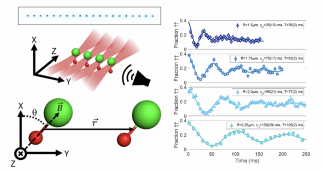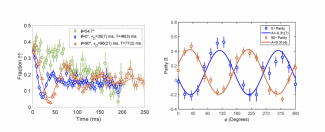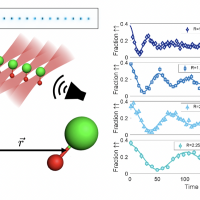News
Quantum entanglement between ultracold molecules in optical tweezer array
Molecular tweezer arrays provide a powerful and versatile platform for quantum computing and simulation applications. This is due to the long coherence time, strong dipole-dipole couplings between neighboring polar molecules, and single-site addressability in the system. Recently, by using the rotational states of single CaF molecules trapped in individual tweezers as effective qubits, we have realized a two-qubit gate to generate quantum entanglement between a pair of molecules (Fig 1a).
Specifically, we initially prepare ultracold molecules in a superposition state of pure rotational states through the techniques of optical pumping and microwave pulses. By moving two molecules in close proximity using the optical tweezers, where dipolar coupling becomes prominent, we observe an oscillation of the probability that both molecules are in the excited rotational state. The oscillation frequency increases as the spacing between tweezer pairs is reduced (Fig 1b).
Since the dipolar interaction is intrinsically anisotropic, we are able to study this effect by tuning the angle θ between the quantization field axis and the intermolecular direction (Fig 2a). Utilizing this exchange interaction, we then generate a maximally entangled state (a “Bell state”). The measured parity oscillation shows that they can create both anti-ferromagnetic interaction with θ=90° and ferromagnetic interaction with θ=0° (Fig 2b). Further reading link [1]
We also demonstrate single site addressability in a tweezer array by tuning the trap depth to shield molecules from a global microwave transfer. This can be used to implement arbitrary initial state preparation, when combined with the two-qubit gate operation mentioned above, we have all the building blocks required to use ultracold molecules for quantum computing. This work opens the door for using molecules to exploit high-fidelity dipolar interaction for a variety of quantum information and simulation applications.

Fig 1. (a) Experimental setup showing molecules trapped in an optical tweezer array. (b) Dipolar spin-exchange oscillation at various tweezer distances.

Fig 2. (a) Dipolar spin-exchange oscillation at three characteristic angles θ. Data show the oscillation frequency in a head-to-tail configuration is twice of that in a parallel configuration. No oscillation is observed for θ = 54.7°. (b) Parity oscillation of the Bell state at different θ angles. We can realize both anti-ferromagnetic interactions and ferromagnetic interactions depending on the θ angle.
References:
[1] Bao, Yicheng, et al. “Dipolar spin-exchange and entanglement between molecules in an optical tweezer array.” arXiv preprint arXiv:2211.09780 (2022).
